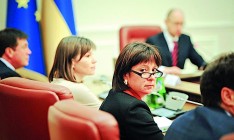Economy
ReformDubious asset. Ukrzaliznytsya owes more than it is worth

Ukrainian railroaders chose not the best time for the reform of the sector. Profitable cargo traffic is about to become unprofitable without updating and modernization of the rolling stock. End-users stop using unprofitable passenger services. For example, based on the results of the first six months of this year the passenger turnover on the railway declined by 26.8% compared to the same period in 2013. Such a decrease has not been seen since the disastrous 1991.
Restructuring
In late June, the Cabinet of Ministers approved Decree No. 200 On Creation of the Ukrainian Railway Public Joint Stock Company, according to which from the beginning of the next year a PJSC with fully public capital shall be created on the basis of Ukrzaliznytsya (UZ). “This is an important step which starts the process of restructuring of the railway sector,” said then Infrastructure Minister Maksym Burbak.
Yet it is somewhat overdue. As a reminder, the Law of Ukraine On Peculiarities of Creation of a Public Joint Stock Company for Public Railway Transport was adopted in February 2012. The final provisions of the document envisage that the government decree on formation of UZ should be approved within three months, but it saw the light only 2.5 years later. It is not improbable that the next steps will be quite sluggish as there is a lot of red tape to go through and corporate delays that can take much more time than provided by the decree.
Officials plan to conduct an inventory of assets of UZ by the end of August 2014 and an independent appraisal of the company’s property by the end of September. By mid-November, the Cabinet will receive a draft decree On Approval of the Charter and Organization of Activities of the Ukrzaliznytsya PJSC. After that UZ will be registered and the formation of its property complex will be completed. It is expected that the complex of UZ will include 25 branches, integrating six railroads and public railway transport companies, state-owned stakes of business entities for the repair of traction and rolling stock, plants for production of reinforced concrete structures, cross-sleepers, etc.
Easy and transparent
Today, the state administration of the railway transport UZ represents the most Soviet of all post-Soviet formations, combining a controlling body and a structure controlled by this body. Chairman of the Expert Council at the Ministry of Infrastructure Oleksandr Kava says “this is an outdated model inherited from the Ministry of Railways of the USSR; it does not provide for the necessary level of transparency and efficiency of the system”. In fact, creation of a public joint stock company will allow to separate these functions, as it will deal exclusively with business activities.
The question is how quickly will the new structure learn to do business the new way and at the same time pay off old debts? Kava hopes that from the moment of establishment of the joint-stock company UZ will be able to enhance cooperation with international financial institutions and simplify its work on the debt market by issuing Eurobonds, attracting syndicated loans, etc. “Today borrowings are made by individual regional railways and cash flows are too complicated and opaque for investors. This leads to a situation when loans are mainly taken out from Ukrainian banks at high interest rates,” says Senior Analyst at the Art Capital investment group Oleksiy Andriychenko.
As a result, today UZ owes more than it is worth. According to the conducted by audit of the EU conducted in spring 2014, the total book value of all the assets of UZ as of December 31, 2013 amounted to UAH 63.7 bn. At the same time, at the beginning of 2014 the company's current liabilities exceeded the cost of current assets by UAH 9.7 bn (at the beginning of 2013 – by UAH 12.46 bn). The management of UZ believes that the deficit of the working capital is common to all providers of railway transportation services. It is assumed that in 2014 Ukrzaliznytsya will cover the deficit by operating activities, additional borrowings with maturities of over one year and, if necessary, by reducing capital investment. As it was noted by the EY, in 2013 Ukrzaliznytsya managed to place Eurobonds to the amount of UAH 3.996 bn, maturing in 2018, which allowed partial refinancing of the current liabilities.
Experts also count on revaluation of assets in accordance with the market mechanisms. At present assessment of market value (capitalization of the company) in terms of absence of incorporated capital is impossible, according to Andriychenko. “Upon creation of the PJSC the fair value of the UZ’s asset will definitely grow,” he hopes.
The question is whether upon corporatization it will be able to run activities profitably enough to serve the current and planned borrowings. Some experts believe that this will be possible if the UZ focuses only on profitable freight traffic and palms off passenger transportation to private investors. But the problem is that involvement of private investors will be possible only upon completion of the third stage of reformation of Ukrainian railway transport (creation of the Ukrzaliznytsya PJSC is only the first stage).
Cargo asset
It should be kept in mind that cargo transportation, which generates profits for the UZ, is the most attractive scope of activities of Ukrainian railways (as well as any other national railways). “It should not be ruled out that in the future domestic legislation can be changed to bring the cargo part of business of the UZ as more cost-effective for IPO,” says Andriychenko.
This being said Ukraine is unique because railway transport, even inclusive of the pipelines, serves more than 50% of the total turnover of the country (exclusive of pipeline transportation – more than 60%).
But the state-owned operator of railway cargo transportation has a big problem – the need to raise substantial funds for modernization of its rolling stock. By the end of 2013 freight car fleet in Ukraine was worn by 88%, according to Ukrzaliznytsya. Taking into account that currently about 130,000 freight cars (including more than 116,000 in possession of the UZ) are used in Ukraine, the need for the new freight cars makes more than 110,000 (which equals to 4 last-year “outputs” of freight cars in Ukraine).
AT Kearney consulting company came to similar conclusions, as its experts prepared a strategic diagnosis of the state of domestic railway industry. They believe to maintain the existing position in the freight market the company requires to purchase 111,000 freight cars by 2020. Experts noted that underinvestment in every 10,000 cars of the aforementioned amount will result in the loss of close to 15 bn t/km of turnover by 2020 (in 2013 the total turnover was close to 88 bn t/km). In monetary terms, such losses are equal to approximately UAH 1.6 bn.
In addition, according to the UZ, taking into consideration that the standard life of locomotives is 30 years, the wear of the tractive fleet (1,547 units) is more that 90%, with an average age of electric locomotives of almost 37 years. The management of UZ believes that more than 500 physically and morally obsolete locomotives are in urgent need of replacement. AT Kearney believes that by 2020 the company should buy more than 2,000 freight locomotives (both electric and diesel locomotives).
Noteworthy is that experts from the market of railway cargo transportation cannot give a precise assessment of funds needed for the purchase of rolling and traction stock. In any case, such amount is much bigger than the above-mentioned cost of assets of the UZ. According to experts from UZ in order to optimize the use of the railway infrastructure (reduction of load in some areas due to the construction of alternative branches, optimization of freight flows, closing unclaimed areas) the company would require total investments of UAH 56 bn.
Passenger liability
The fleet of passenger cars is not in the best condition either (its wear exceeds 90%). But passenger transportation – unlike the cargo segment – is also deeply unprofitable. The head of the Chief Administration for Corporate Development and Reforms at Ukrzaliznytsya Andriy Bukovsky says the organization of passenger transportation by rail in Ukraine is extremely inefficient. “The fact is that nearly 100 routes (0.4% of all connections) between the main cities in Ukraine have been covering almost half the volume of passenger traffic for years. We need to focus our efforts on the development of key routes while closing the notoriously unprofitable directions and eliminating a number of stops along the routes. The target model for the market primarily involves development of daytime transport to popular destinations,” he says.
Experts estimated that by 2020 the number of passengers on daytime high-speed trains should increase fourfold (currently the maintenance of these routes is vested upon a special unit of UZ – the Ukrainian High-speed Railway Company on the balance of which there are 10 Rotem trains manufactured by Hyundai, two trains manufactured by Skoda and another two Tarpan trains from the Kryukov Carriage Works expected in the near future).
To service the increased passenger traffic, the total investment into the renewal of the rolling stock will amount to more than UAH 37 bn. The railway system will need most of these funds a year and a half from now – the large-scale write-off of obsolete railcars is scheduled for 2015. For now, according to UZ’s financial plan for 2014, the company allocated financing for the purchase of one passenger care (!) and modernization of 90 cars.
The situation with the commuter passenger transportation systems is even worse, as the number of passengers using benefits account for 70%. Losses from this type of transportation should be compensated from local budgets. Yet in 2006-2013 the UZ was compensated only 6% of the losses from transportation of people entitled to benefits. As a result, whereas in 2007 Ukrzaliznytsya sustained losses of UAH 1.29 bn on suburban transportation, in 2013 its losses amounted to UAH 3.6 bn. In terms of absence of an effective mechanism for compensation, according to Bukovsky, no investor will be interested in this line of business. Therefore, in future it may be more practical to create regional commuter companies, which will have local authorities among their shareholders in addition to the railway.





 of the agreement of syndication with Financial Times Limited are strictly prohibited. Use of materials which refers to France-Presse, Reuters, Interfax-Ukraine, Ukrainian News, UNIAN agencies is strictly prohibited. Materials marked
of the agreement of syndication with Financial Times Limited are strictly prohibited. Use of materials which refers to France-Presse, Reuters, Interfax-Ukraine, Ukrainian News, UNIAN agencies is strictly prohibited. Materials marked  are published as advertisements.
are published as advertisements.